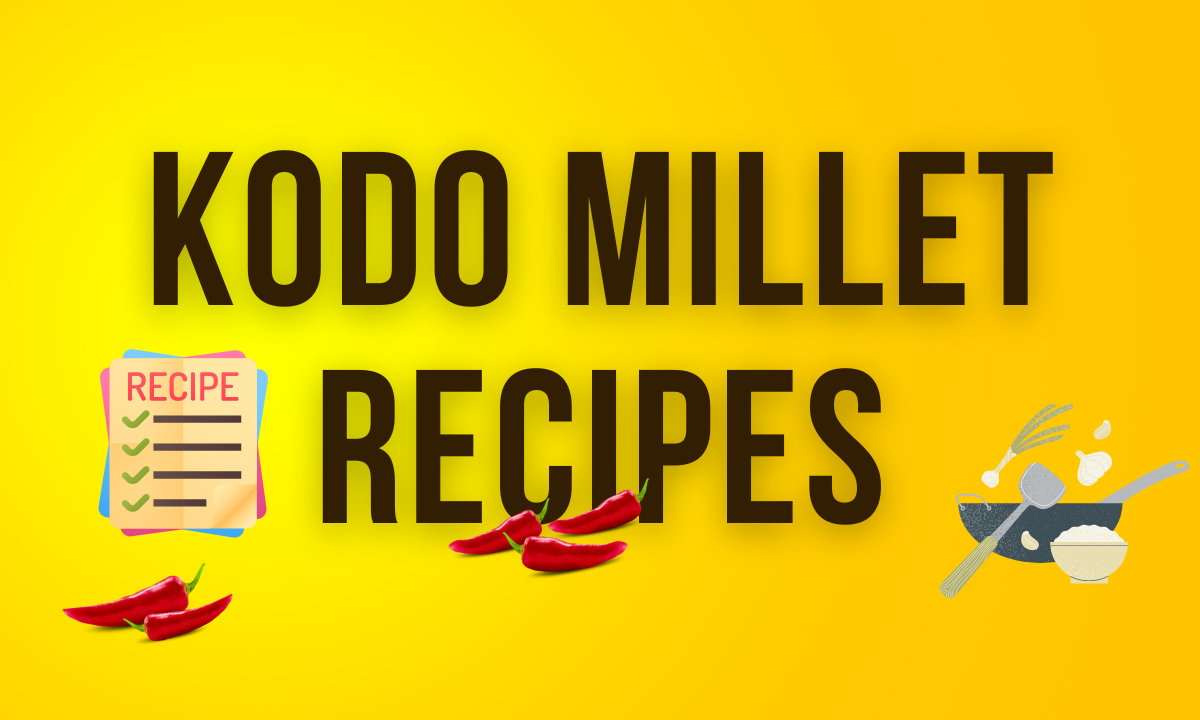In today’s fast-paced world, finding the right balance between taste and nutrition can be challenging. However, ancient grains like Kodo millet offer a perfect solution. Packed with essential nutrients, Kodo millet is not just a staple in traditional Indian kitchens but also a modern superfood. Whether you are looking to add variety to your meals or aiming for a healthier lifestyle, Kodo millet recipes can be your go-to option. From breakfast to dinner, these recipes are versatile, easy to make, and incredibly nutritious.
What is Kodo Millet?
Kodo millet, also known as ‘Varagu’ in Tamil, ‘Arikelu’ in Telugu, and ‘Kodri’ in Gujarati, is a small, drought-resistant grain that has been cultivated in India for thousands of years. This ancient grain is a member of the millet family and is known for its high nutritional value. Unlike rice and wheat, Kodo millet is gluten-free, making it an excellent choice for those with gluten intolerance or celiac disease.
Kodo millet has a unique nutty flavor and a slightly chewy texture, which makes it a versatile ingredient in various dishes. It can be used to prepare a wide range of recipes, from breakfast porridge and upma to savory pulao and even desserts. Its ability to absorb flavors makes it a favorite among chefs and home cooks alike.
Health Benefits of Kodo Millet
Incorporating Kodo millet into your diet can bring numerous health benefits, thanks to its rich nutrient profile. Here are some of the key health benefits of Kodo millet:
- Rich in Fiber
- Supports Weight Loss
- Gluten-Free Alternative
- Rich in Antioxidants
- Boosts Immunity
- Improves Heart Health
By including Kodo millet in your daily meals, you can enjoy these health benefits while also indulging in delicious and satisfying dishes. Whether you are looking to improve your overall health or manage specific conditions, Kodo millet recipes can be a valuable addition to your diet.
How to Cook Kodo Millet: Basic Preparation
Before diving into the recipes, it’s essential to know how to prepare kodo millet. Here’s a simple step-by-step guide:
- Rinse the Millet: Start by rinsing the kodo millet under cold water. This helps in removing any dust or impurities.
- Soak the Millet: Soak the millet in water for about 15-20 minutes. This softens the grains and makes them easier to cook.
- Cook the Millet: For every cup of kodo millet, use two cups of water. Bring it to a boil, then reduce the heat to a simmer, cover, and cook for 15-20 minutes until the water is absorbed and the millet is tender.
Now that you know how to prepare kodo millet, let’s explore some nutritious and easy-to-make Kodo Millet recipes.

1. Kodo Millet Upma (Kodo Millet Breakfast Recipe)
Upma is a popular South Indian breakfast dish, and when made with kodo millet, it becomes even more nutritious. Here’s how to make it:
Ingredients:
- 1 cup kodo millet
- 1 tablespoon oil
- 1 teaspoon mustard seeds
- 1 teaspoon urad dal
- 1 onion, chopped
- 1 carrot, chopped
- 1/2 cup green peas
- 2-3 green chilies, chopped
- Curry leaves
- Salt to taste
- Water as required
Instructions:
- Cook the kodo millet as described above.
- In a pan, heat oil and add mustard seeds, urad dal, and curry leaves. Sauté until they crackle.
- Add onions, green chilies, and sauté until onions turn translucent.
- Add chopped vegetables and cook until they are tender.
- Mix in the cooked kodo millet and stir well. Cook for another 2-3 minutes.
- Serve hot with a side of coconut chutney.
Protein Content: Approximately 6-8 grams of protein per serving.
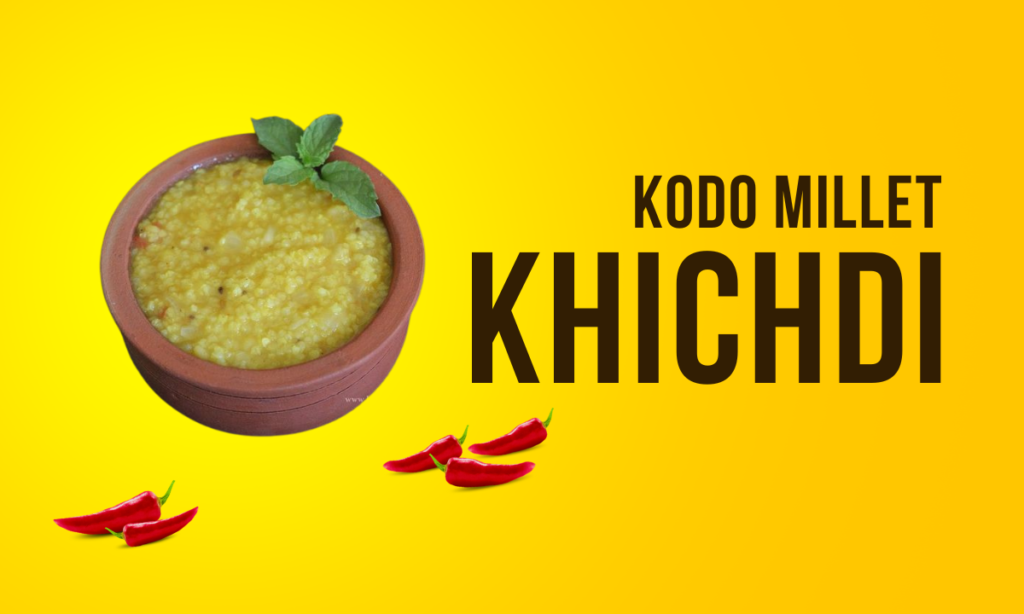
2. Kodo Millet Khichdi (Kodo Millet Recipe Indian Style)
Khichdi is a comforting and wholesome dish. Here’s a healthy version using kodo millet:
Ingredients:
- 1 cup kodo millet
- 1/2 cup moong dal
- 1 tablespoon ghee
- 1 teaspoon cumin seeds
- 1 teaspoon turmeric powder
- 1 carrot, diced
- 1 potato, diced
- 1 tomato, chopped
- Salt to taste
- Water as required
Instructions:
- Cook the kodo millet and moong dal together with water, turmeric powder, and salt in a pressure cooker for 3-4 whistles.
- In a separate pan, heat ghee and add cumin seeds. Once they crackle, add the vegetables and sauté until they are soft.
- Add the cooked millet and dal mixture to the vegetables and mix well. Cook for 5-7 minutes on low heat.
- Serve hot with a dollop of ghee and a side of pickles or yogurt.
Protein Content: Approximately 10-12 grams of protein per serving.
Also Read PCOS Breakfast Indian: Nutritious and Easy Ideas.
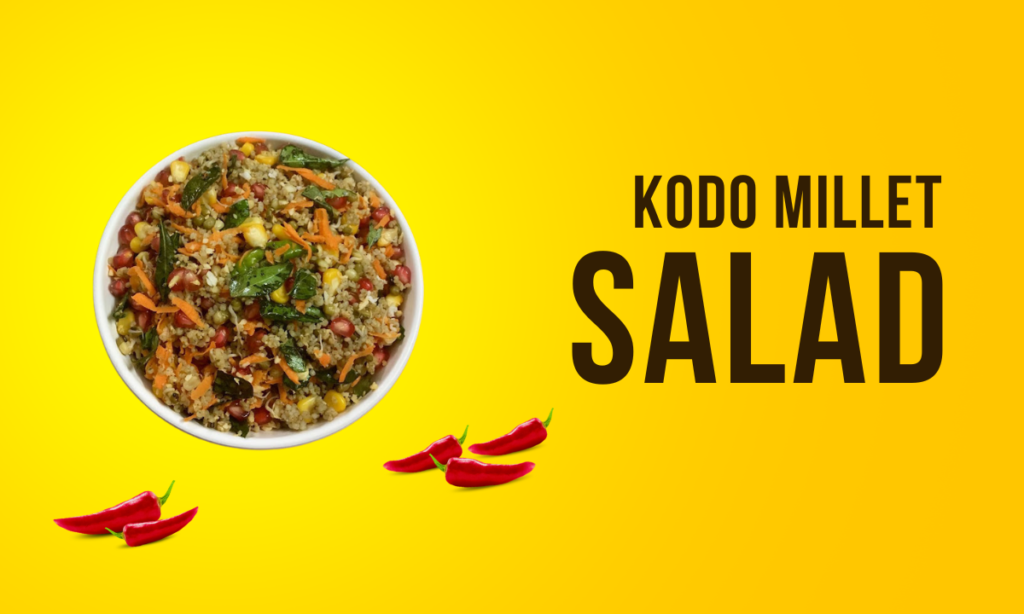
3. Kodo Millet Salad (Kodo Millet Recipes for Weight Loss)
This light and refreshing salad is perfect for those looking to manage their weight while enjoying a tasty meal:
Ingredients:
- 1 cup cooked kodo millet
- 1 cucumber, chopped
- 1 tomato, chopped
- 1 carrot, grated
- 1/4 cup boiled corn
- 1 tablespoon lemon juice
- 1 teaspoon olive oil
- Salt and pepper to taste
Instructions:
- In a large bowl, combine the cooked kodo millet, cucumber, tomato, carrot, and boiled corn.
- Drizzle olive oil and lemon juice over the salad.
- Season with salt and pepper, and toss everything together.
- Serve chilled or at room temperature.
Protein Content: Approximately 4-6 grams of protein per serving.
Also Read 12 Indian Breakfast Foods That Are Vegan And High In Protein.

4. Kodo Millet Pongal (Kodo Millet Recipes Indian Style)
Pongal is a traditional South Indian dish, and using kodo millet makes it a healthier alternative. It’s a simple, comforting, and nutritious dish perfect for breakfast or lunch.
Ingredients:
- 1 cup kodo millet
- 1/2 cup moong dal
- 1 tablespoon ghee
- 1 teaspoon cumin seeds
- 1 teaspoon black pepper
- A pinch of asafoetida (hing)
- 10-12 curry leaves
- 10-12 cashews
- Salt to taste
- Water as required
Instructions:
- Dry roast the moong dal in a pan until it turns light golden.
- Wash and cook the kodo millet and moong dal together with 3 cups of water in a pressure cooker for 3-4 whistles.
- In a separate pan, heat ghee and add cumin seeds, black pepper, asafoetida, curry leaves, and cashews. Fry until the cashews turn golden brown.
- Add this tempering to the cooked millet and dal mixture. Mix well and cook for another 2-3 minutes.
- Serve hot with coconut chutney or sambar.
Protein Content: Approximately 8-10 grams of protein per serving.

5. Kodo Millet Pulao (Kodo Millet Recipes Vegetarian)
Pulao is a one-pot dish that is flavorful and easy to make. This version with kodo millet is a delicious way to enjoy a healthy meal.
Ingredients:
- 1 cup kodo millet
- 1 tablespoon oil
- 1 bay leaf
- 1 cinnamon stick
- 2-3 cloves
- 1 onion, sliced
- 1 carrot, chopped
- 1 potato, diced
- 1/2 cup green peas
- 1 teaspoon ginger-garlic paste
- 1 teaspoon garam masala
- Salt to taste
- Water as required
Instructions:
- Cook the kodo millet as described in the basic preparation.
- In a pan, heat oil and add bay leaf, cinnamon stick, and cloves. Sauté until fragrant.
- Add the sliced onions and sauté until they turn golden brown.
- Add ginger-garlic paste and cook until the raw smell disappears.
- Add the chopped vegetables, salt, and garam masala, and cook for 5-7 minutes until the vegetables are tender.
- Mix in the cooked kodo millet and stir well. Cook for another 3-4 minutes.
- Serve hot with raita or plain yogurt.
Protein Content: Approximately 7-9 grams of protein per serving.
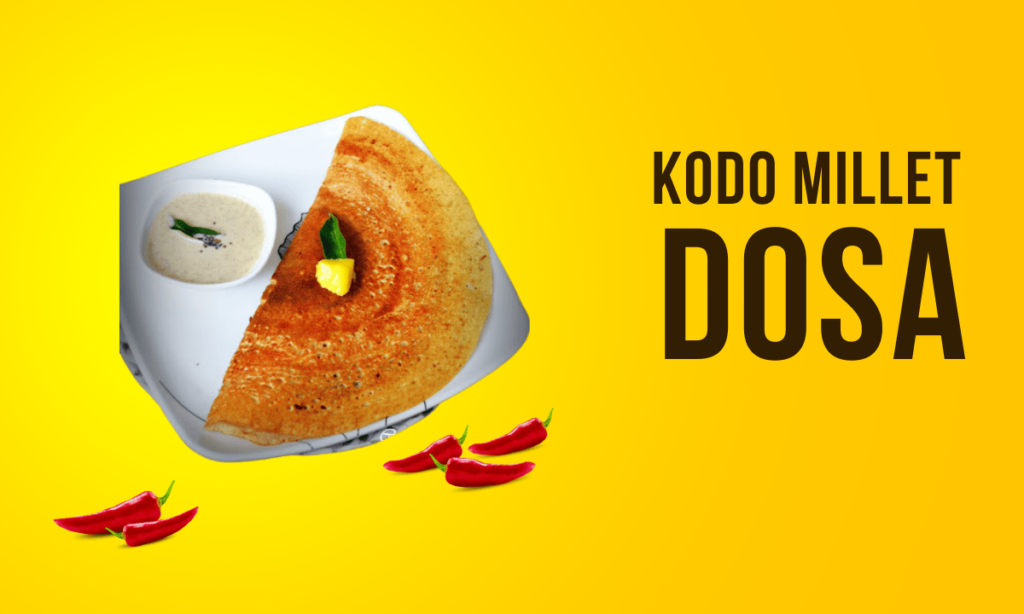
6. Kodo Millet Dosa (Kodo Millet Breakfast Recipes)
Dosa is a beloved South Indian breakfast dish, and making it with kodo millet adds a healthy twist. This crispy dosa is perfect for a nutritious start to the day.
Ingredients:
- 1 cup kodo millet
- 1/2 cup urad dal
- 1/4 cup poha (flattened rice)
- Salt to taste
- Water as required
- Oil for cooking
Instructions:
- Soak the kodo millet, urad dal, and poha separately for 4-6 hours.
- Grind them together into a smooth batter, adding water as needed. The batter should be of pouring consistency.
- Add salt and allow the batter to ferment overnight or for 8-10 hours.
- Heat a dosa tawa (griddle) and pour a ladleful of batter, spreading it in a circular motion to form a thin dosa.
- Drizzle oil around the edges and cook until golden and crispy.
- Serve hot with chutney and sambar.
Protein Content: Approximately 5-7 grams of protein per dosa.

7. Kodo Millet Stir-Fry (Kodo Millet Recipes Vegetarian)
This quick and easy stir-fry made with kodo millet is perfect for a nutritious and satisfying vegetarian meal.
Ingredients:
- 1 cup cooked kodo millet
- 1 tablespoon olive oil
- 1 onion, sliced
- 1 bell pepper, sliced
- 1 carrot, julienned
- 1/2 cup broccoli florets
- 2 cloves garlic, minced
- 1 tablespoon soy sauce
- 1/2 teaspoon black pepper
- Salt to taste
Instructions:
- In a large pan, heat olive oil over medium heat. Add garlic and sauté until fragrant.
- Add the sliced onion, bell pepper, carrot, and broccoli. Stir-fry the vegetables until they are tender but still crisp.
- Add the cooked kodo millet to the pan and stir to combine.
- Pour in soy sauce, and season with black pepper and salt. Stir well to coat the millet and vegetables evenly.
- Cook for another 2-3 minutes until the flavors are well combined.
- Serve hot as a main dish or a side.
Protein Content: Approximately 6-8 grams per serving.

8. Kodo Millet Pancakes (Kodo Millet Breakfast Recipes)
Kodo millet can be used to create delicious and nutritious pancakes, perfect for a healthy breakfast.
Ingredients:
- 1 cup kodo millet flour
- 1/2 cup cooked kodo millet
- 1/2 cup yogurt
- 1/2 teaspoon baking soda
- 1 tablespoon honey
- 1/4 cup milk (as needed)
- A pinch of salt
- Ghee or oil for cooking
Instructions:
- In a mixing bowl, combine kodo millet flour, cooked kodo millet, yogurt, baking soda, honey, and salt. Mix well.
- Gradually add milk to the mixture, stirring until you achieve a thick batter consistency.
- Heat a pan and lightly grease it with ghee or oil.
- Pour a ladleful of batter onto the pan, spreading it slightly to form a pancake.
- Cook on medium heat until bubbles form on the surface, then flip and cook the other side until golden brown.
- Serve hot with honey, maple syrup, or fresh fruits.
Protein Content: Approximately 5-7 grams per serving.
Instructions:
- Dry roast the kodo millet in a pan until lightly golden. Set aside.
- In a pan, heat oil and add mustard seeds, urad dal, and chana dal. Sauté until the dals turn golden brown.
- Add chopped onion, carrot, curry leaves, green chilies, and ginger paste. Sauté until the onions turn translucent.
- Add turmeric powder and salt. Mix well.
- Add 2 cups of water and bring it to a boil.
- Add the roasted kodo millet, stir well, cover, and cook on low heat until the millet is fully cooked and the water is absorbed.
- Fluff the upma with a fork and serve hot with coconut chutney.
Protein Content: Approximately 6-8 grams of protein per serving.
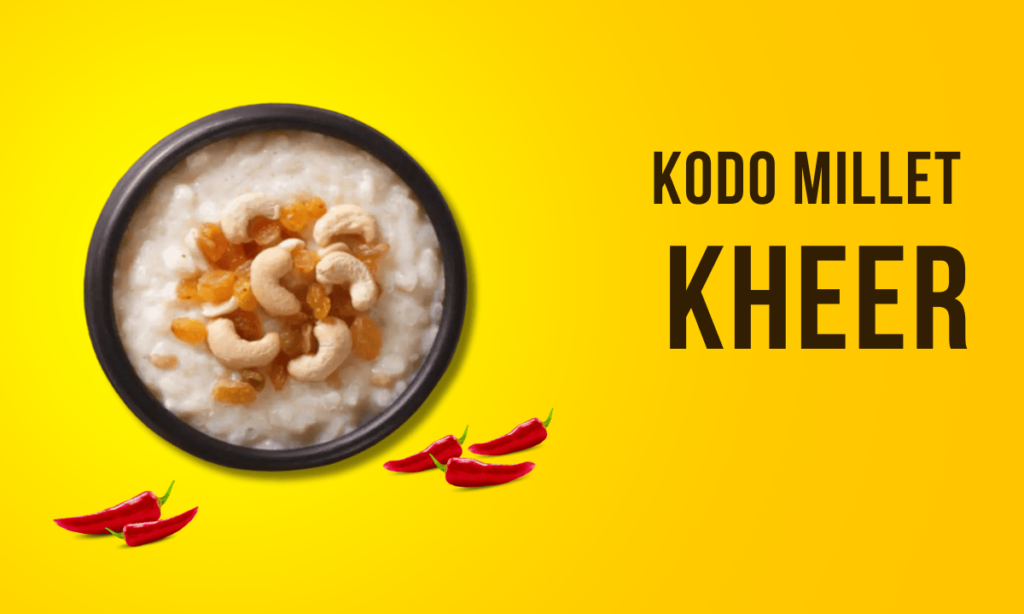
9. Kodo Millet Kheer (Kodo Millet Recipes Vegetarian)
Kheer is a traditional Indian dessert, and kodo millet adds a healthy twist to this sweet treat. It’s perfect for festive occasions or as a dessert after a meal.
Ingredients:
- 1/2 cup kodo millet
- 4 cups milk
- 1/2 cup sugar
- 1/4 teaspoon cardamom powder
- 10-12 cashews
- 10-12 raisins
- 1 tablespoon ghee
- Saffron strands for garnish (optional)
Instructions:
- Wash and soak the kodo millet for 30 minutes.
- In a pan, heat ghee and roast the cashews and raisins until golden. Set aside.
- In the same pan, add the soaked kodo millet and cook for 5-7 minutes, stirring continuously.
- Add milk and cook the millet on low heat until it becomes soft and the milk thickens.
- Add sugar and cardamom powder, and cook for another 5 minutes.
- Garnish with roasted cashews, raisins, and saffron strands.
- Serve warm or chilled as desired.
Protein Content: Approximately 4-5 grams of protein per serving.
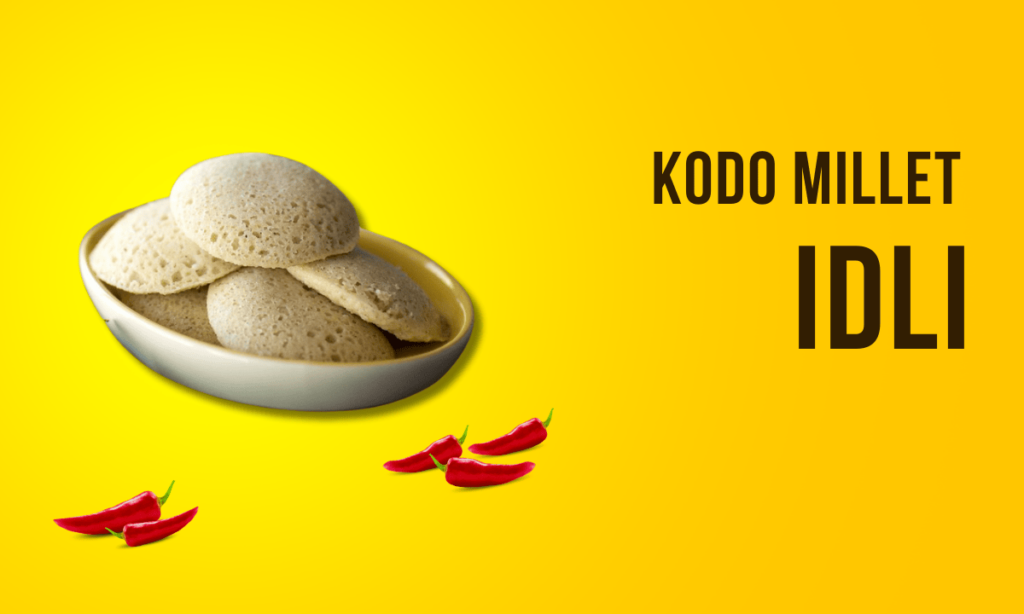
10. Kodo Millet Idli (Kodo Millet Recipes for Weight Loss)
Idli is a staple breakfast in South India, and using kodo millet makes it a healthier alternative. These idlis are light, fluffy, and perfect for a weight-loss diet.
Ingredients:
- 1 cup kodo millet
- 1/2 cup urad dal
- 1/4 cup poha (flattened rice)
- Salt to taste
- Water as required
Instructions:
- Wash and soak the Kodo millet, urad dal, and poha separately for 4-6 hours.
- Grind them together into a smooth batter, adding water as needed. The batter should be of thick pouring consistency.
- Add salt and allow the batter to ferment overnight or for 8-10 hours.
- Pour the batter into greased idli molds and steam for 10-12 minutes until the idlis are cooked through.
- Serve hot with coconut chutney and sambar.
Protein Content: Approximately 6-8 grams of protein per idli.
Conclusion
Kodo millet is not only a powerhouse of nutrition but also incredibly versatile, fitting seamlessly into a variety of dishes. From traditional Indian recipes like pongal and dosa to more contemporary options like pulao and salad, kodo millet can be a fantastic addition to your diet. Whether you’re focusing on weight loss, looking for vegetarian options, or simply want to enjoy a healthy meal, these kodo millet recipes are sure to satisfy your taste buds and nourish your body.
FAQs
1. Should kodo millet be soaked before cooking?
Yes, it is recommended to soak kodo millet before cooking. Soaking for about 3-4 hours helps reduce cooking time and improves digestibility. It also helps in removing any phytic acid, which can hinder the absorption of minerals. Soaking the millet makes it softer and easier to cook, resulting in a fluffier texture.
2. Can we eat kodo millet daily?
Yes, kodo millet can be eaten daily as part of a balanced diet. It is a nutritious grain that provides a good source of protein, fiber, and essential nutrients like iron and magnesium. However, it’s important to ensure variety in your diet, so incorporating other whole grains and food groups is recommended to meet all nutritional needs.
3. Is kodo millet better than rice?
Kodo millet is considered nutritionally superior to rice, particularly polished white rice. It has a lower glycemic index, making it a better option for managing blood sugar levels. Kodo millet is also richer in dietary fiber, protein, and minerals like calcium and magnesium. For those looking to lose weight or manage diabetes, kodo millet can be a healthier alternative to rice.
4. Is kodo millet heat or cold?
Kodo millet is generally considered a warming grain, which means it generates heat in the body when consumed. This makes it suitable for cooler climates or seasons. However, it can be enjoyed year-round, especially when prepared with cooling ingredients like yogurt or served as a salad, to balance its warming properties.
